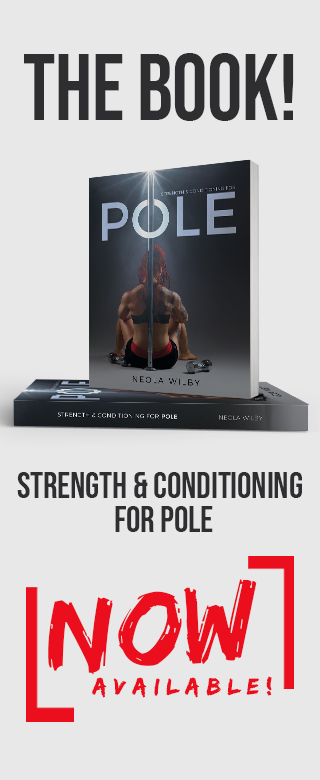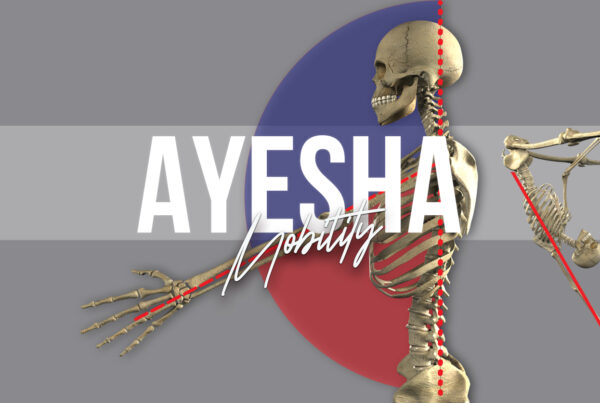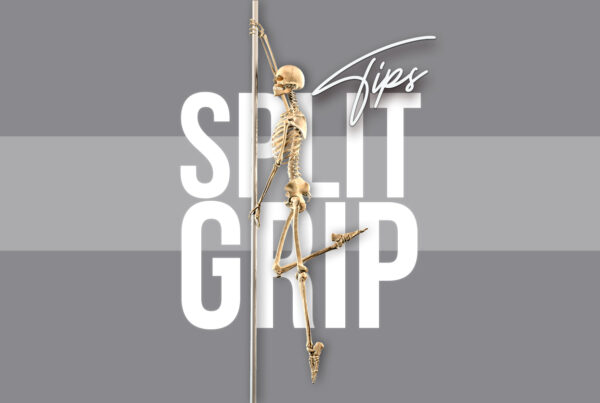If you joined me and my ever-endearing pole dancing skelly on the blog last month, you’ll already know alllll the needs to know about hip flexion – what it is and why it’s important for pole dancers!
If you missed that, get it ticked off your pole nerding to-do-list before we continue!
Here’s the post! >>Hip flexion – what is it and why is it important for pole dancers?<<
Today, we’re leaving the “but whyyy Mum?” of hip flexion behind and moving on to the more practical “but howww???”!
So… how can we improve our hip flexion range and strength for pole dance?
Oh boy, I’m so glad you asked!
Creating flexibility-targeted workouts for pole dancers
When it comes to the sports science behind flexibility training, the research seems to show that a whole LOAD of different approaches work—passive stretching, end-range strength work, PNF stretching, foam rolling etc, etc. So when I’m planning workouts for my clients, and for my online programmes, I use a combination of these techniques together, based on what I’ve seen works well in practice over the years.
Here are some of the key ones:
- Eccentric exercises
- End-range strength exercises
- Passive stretching
- PNF stretching
- Foam rolling
There are many ways to incorporate these elements into your programming. When I’m looking to create a single end-range/flexibility focused hip workout, here’s a rough structure that is typical of what I’d create for my pole dance clients:
| WARM UP | EXERCISES | STRETCH |
| – 5 min general warm up – Foam rolling – Nerve flossing (if required) – Activation exercises and workout specific dynamic stretches | 1 x eccentric exercise 1 x end-range strength exercise 1 x rotation focused exercise | – 1 x PNF Stretch – Passive stretches |
This creates a super short workout that covers all key bases without adding too much volume (because, hey, we’re pole dancers, we’ve got a lot to get through!).
You’ll see that I’ve included some hip rotation work in the main exercises. This is primarily because hip rotation and control is such a key element of good hip mobility in general. I’ve found that where clients have rotation limitations, working on improving that can have a big knock-on effect on their overall hip flexibility in other directions, too. In technical terms: mobility magic, woo! 😉
Applying this workout structure to hip flexion, that workout sequence might look a little like this:
| EXAMPLE: HIP FLEXION WORKOUT FOR POLE DANCERS | ||
| WARM UP | EXERCISES | STRETCH |
| (5 min) General warm up* 30s each, twice through: Jog High knees Squat Over and unders (left side) Over and unders (right side) (2 min) Foam rolling** 60 seconds on each side: Mobility roll hamstrings Nerve flossing (if needed)*** 2 x 10 reps: Sciatic nerve flossing This should be a slow, pain-free motion! Activation exercises / workout specific dynamic stretches 60s each: Walking lunge with hamstring stretch Supine active leg lifts | You can either do each exercise on its own (2 to 3 sets, resting around 30 seconds between each set), or, if you want to make this faster you can combine the exercises together into a circuit (do each exercise one after the other 2 or 3 times through). Eccentric exercise: Single leg deadlift 5 on each side. For each repetition, do a 5 second lower, hold the bottom position for 5 seconds, then stand! End-range strength exercise: Stability ball wall hold 10 reps, alternating legs. Hip rotation exercise: Supine internal hip rotation 5 x 5 second holds in your end range! | Hamstring PNF stretch sequence 2 – 3 times through Passive stretches 30s each: Forward fold Pancake stretch |
| *Note on general warm up: This can really be any general movement to get your blood flowing and get you feeling a little warmer, with a focus on lower body! **Note on foam rolling: Obviously, for hip flexion, we’re focusing our foam rolling on the hamstrings, but you can add other areas if you know you have other areas of tightness that impact your hip flexion mobility. For example, I have tight adductors that restrict my open splits position, so I would include 60s on each side of adductor rolling here, too. ***Note on nerve flossing: Not sure if you should include nerve flossing in your warm up? Check out my post: Is nerve tension holding back your hamstring flexibility? | ||
Remember, you’re a unique and special snowflake!
I really can’t stress this enough: it’s important to focus on the areas YOU need to work on most! We all have our own unique strengths, weaknesses and movement patterns—you’re gonna get the most out of your training if you know which areas are restricted/weaker than others!
The more you can tailor your exercise programming to your own body, the more productive your training time will be! Like I said, we got sh*t to do—life’s way too short to waste on exercises that don’t help us get directly to our goals!
For example, I know my internal hip rotation range and strength is weaker than my external hip rotation range and strength, so when I work on rotation exercises in my own training, I bias internal rotation because I know that’s where I’ll get the most benefit.
If your hip flexion range and strength is fairly solid but you struggle when combining it with other movements on the pole, including additional exercises that combine the hip flexion movement with core stability or other elements might be the way to go!
If you know your anterior pelvic tilt is excessive (and/or your posterior pelvic tilt is limited), adding some work on that might just create a little mobility magic for your hips!
You do you, boo!
Remember, too, that although the examples I’ve given focus on hip flexion in that more neutral position (i.e. sagittal plane… i.e. think ‘front splits’ position) we actually flex our hips in lots of different positions when we pole. In particular, we combine it with hip abduction and external rotation for all those spreadies to the Gods, so depending on your goals, working hip flexion outside of this sagittal plane is also something to consider when looking at the bigger picture of progressions and programming for pole!
Want some help figuring out where your own strengths and weaknesses are? My book, Strength and Conditioning for Pole contains tests for all the key areas along with a framework so you can build your own ass-kicking training programme for pole! Bring on the pole nerding and let’s get strong for pole the sports science way!








